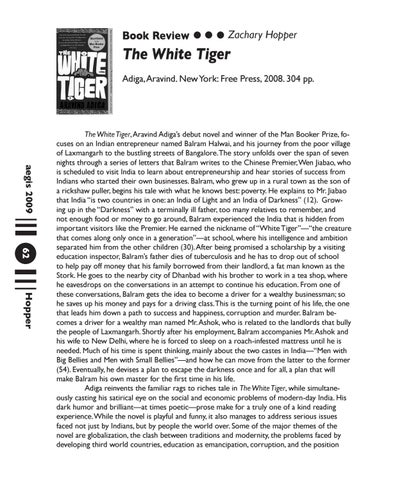Book Review
Zachary Hopper
The White Tiger Adiga, Aravind. New York: Free Press, 2008. 304 pp.
aegis 2009 62 Hopper
The White Tiger, Aravind Adiga’s debut novel and winner of the Man Booker Prize, focuses on an Indian entrepreneur named Balram Halwai, and his journey from the poor village of Laxmangarh to the bustling streets of Bangalore. The story unfolds over the span of seven nights through a series of letters that Balram writes to the Chinese Premier, Wen Jiabao, who is scheduled to visit India to learn about entrepreneurship and hear stories of success from Indians who started their own businesses. Balram, who grew up in a rural town as the son of a rickshaw puller, begins his tale with what he knows best: poverty. He explains to Mr. Jiabao that India “is two countries in one: an India of Light and an India of Darkness” (12). Growing up in the “Darkness” with a terminally ill father, too many relatives to remember, and not enough food or money to go around, Balram experienced the India that is hidden from important visitors like the Premier. He earned the nickname of “White Tiger”—“the creature that comes along only once in a generation”—at school, where his intelligence and ambition separated him from the other children (30). After being promised a scholarship by a visiting education inspector, Balram’s father dies of tuberculosis and he has to drop out of school to help pay off money that his family borrowed from their landlord, a fat man known as the Stork. He goes to the nearby city of Dhanbad with his brother to work in a tea shop, where he eavesdrops on the conversations in an attempt to continue his education. From one of these conversations, Balram gets the idea to become a driver for a wealthy businessman; so he saves up his money and pays for a driving class. This is the turning point of his life, the one that leads him down a path to success and happiness, corruption and murder. Balram becomes a driver for a wealthy man named Mr. Ashok, who is related to the landlords that bully the people of Laxmangarh. Shortly after his employment, Balram accompanies Mr. Ashok and his wife to New Delhi, where he is forced to sleep on a roach-infested mattress until he is needed. Much of his time is spent thinking, mainly about the two castes in India—“Men with Big Bellies and Men with Small Bellies”—and how he can move from the latter to the former (54). Eventually, he devises a plan to escape the darkness once and for all, a plan that will make Balram his own master for the first time in his life. Adiga reinvents the familiar rags to riches tale in The White Tiger, while simultaneously casting his satirical eye on the social and economic problems of modern-day India. His dark humor and brilliant—at times poetic—prose make for a truly one of a kind reading experience. While the novel is playful and funny, it also manages to address serious issues faced not just by Indians, but by people the world over. Some of the major themes of the novel are globalization, the clash between traditions and modernity, the problems faced by developing third world countries, education as emancipation, corruption, and the position

